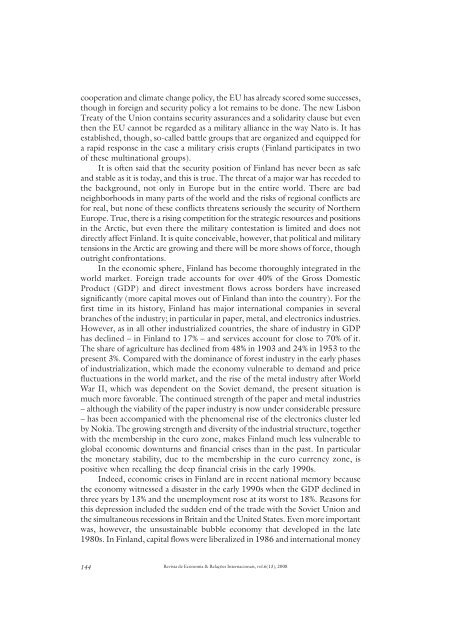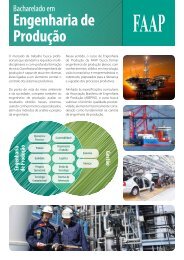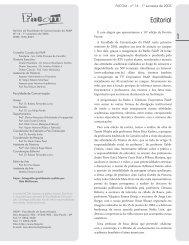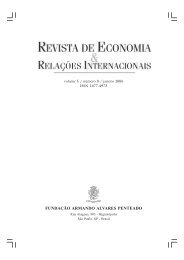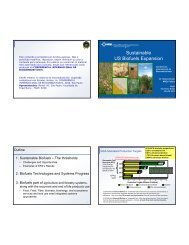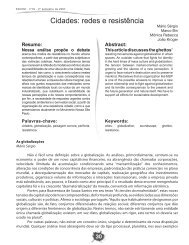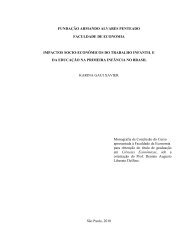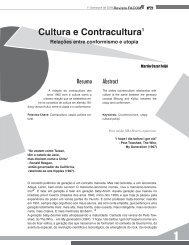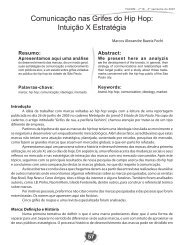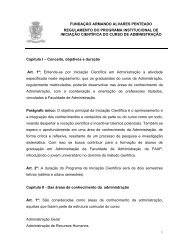Revista Economia n. 13.pmd - Faap
Revista Economia n. 13.pmd - Faap
Revista Economia n. 13.pmd - Faap
You also want an ePaper? Increase the reach of your titles
YUMPU automatically turns print PDFs into web optimized ePapers that Google loves.
cooperation and climate change policy, the EU has already scored some successes,<br />
though in foreign and security policy a lot remains to be done. The new Lisbon<br />
Treaty of the Union contains security assurances and a solidarity clause but even<br />
then the EU cannot be regarded as a military alliance in the way Nato is. It has<br />
established, though, so-called battle groups that are organized and equipped for<br />
a rapid response in the case a military crisis erupts (Finland participates in two<br />
of these multinational groups).<br />
It is often said that the security position of Finland has never been as safe<br />
and stable as it is today, and this is true. The threat of a major war has receded to<br />
the background, not only in Europe but in the entire world. There are bad<br />
neighborhoods in many parts of the world and the risks of regional conflicts are<br />
for real, but none of these conflicts threatens seriously the security of Northern<br />
Europe. True, there is a rising competition for the strategic resources and positions<br />
in the Arctic, but even there the military contestation is limited and does not<br />
directly affect Finland. It is quite conceivable, however, that political and military<br />
tensions in the Arctic are growing and there will be more shows of force, though<br />
outright confrontations.<br />
In the economic sphere, Finland has become thoroughly integrated in the<br />
world market. Foreign trade accounts for over 40% of the Gross Domestic<br />
Product (GDP) and direct investment flows across borders have increased<br />
significantly (more capital moves out of Finland than into the country). For the<br />
first time in its history, Finland has major international companies in several<br />
branches of the industry; in particular in paper, metal, and electronics industries.<br />
However, as in all other industrialized countries, the share of industry in GDP<br />
has declined – in Finland to 17% – and services account for close to 70% of it.<br />
The share of agriculture has declined from 48% in 1903 and 24% in 1953 to the<br />
present 3%. Compared with the dominance of forest industry in the early phases<br />
of industrialization, which made the economy vulnerable to demand and price<br />
fluctuations in the world market, and the rise of the metal industry after World<br />
War II, which was dependent on the Soviet demand, the present situation is<br />
much more favorable. The continued strength of the paper and metal industries<br />
– although the viability of the paper industry is now under considerable pressure<br />
– has been accompanied with the phenomenal rise of the electronics cluster led<br />
by Nokia. The growing strength and diversity of the industrial structure, together<br />
with the membership in the euro zone, makes Finland much less vulnerable to<br />
global economic downturns and financial crises than in the past. In particular<br />
the monetary stability, due to the membership in the euro currency zone, is<br />
positive when recalling the deep financial crisis in the early 1990s.<br />
Indeed, economic crises in Finland are in recent national memory because<br />
the economy witnessed a disaster in the early 1990s when the GDP declined in<br />
three years by 13% and the unemployment rose at its worst to 18%. Reasons for<br />
this depression included the sudden end of the trade with the Soviet Union and<br />
the simultaneous recessions in Britain and the United States. Even more important<br />
was, however, the unsustainable bubble economy that developed in the late<br />
1980s. In Finland, capital flows were liberalized in 1986 and international money<br />
144<br />
<strong>Revista</strong> de <strong>Economia</strong> & Relações Internacionais, vol.6(13), 2008


